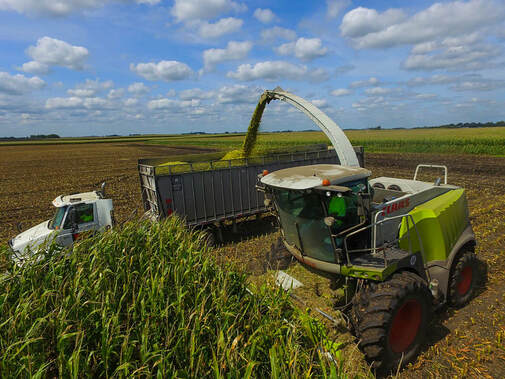Crop Production

Our crop production team works hard year-round to provide high-quality feed for our animals. Cattle are fed corn silage, haylage and other feedstuffs as part of a balanced ration. Feed is stored in buildings or under covers to protect its quality. The products from approximately one acre (the size of one football field) will feed one cow for one year. Half of that acre would be harvested as corn silage and the rest would be alfalfa hay and wheat straw.
Rotational crops like soybeans, wheat and edible bean help keep the soil healthy. Where the soil is sandy or very light, we use pivot irrigation systems to sustain the crops.
It is also important to replace soil nutrients that are used by the crops. Animals produce manure, which can be applied to the fields as fertilizer. One cow produces enough organic fertilizer for ¾ acre of land per year. The liquid manure is stored in covered manure basins until harvest is finished. Then the manure is directly injected into the soil.
Before sending the dairy manure to the basin, we separate the solid portion out of the manure to reuse as bedding in the stalls. This renewable product provides a comfortable place for the cows to lie down. Solids that are not used in the barns can be spread on the cropland to enhance the soil composition. Whether applying solid or liquid manure, a manure management plan is followed in compliance with our states’ environmental regulations.
Rainwater and snow melt are collected in separate basins to be used for irrigation throughout the upcoming growing season. Using this water reduces our use of ground water. We believe good land and resource stewardship is vital to our communities, country and world.
Rotational crops like soybeans, wheat and edible bean help keep the soil healthy. Where the soil is sandy or very light, we use pivot irrigation systems to sustain the crops.
It is also important to replace soil nutrients that are used by the crops. Animals produce manure, which can be applied to the fields as fertilizer. One cow produces enough organic fertilizer for ¾ acre of land per year. The liquid manure is stored in covered manure basins until harvest is finished. Then the manure is directly injected into the soil.
Before sending the dairy manure to the basin, we separate the solid portion out of the manure to reuse as bedding in the stalls. This renewable product provides a comfortable place for the cows to lie down. Solids that are not used in the barns can be spread on the cropland to enhance the soil composition. Whether applying solid or liquid manure, a manure management plan is followed in compliance with our states’ environmental regulations.
Rainwater and snow melt are collected in separate basins to be used for irrigation throughout the upcoming growing season. Using this water reduces our use of ground water. We believe good land and resource stewardship is vital to our communities, country and world.
